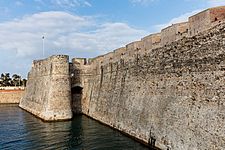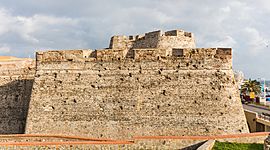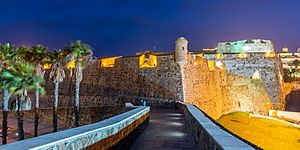Royal Walls of Ceuta facts for kids
Quick facts for kids Royal Walls of Ceuta |
|
|---|---|
| Murallas Reales de Ceuta | |
| Ceuta, Spain | |
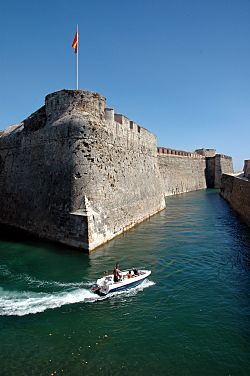
The Royal Walls and their sea-filled ditch
|
|
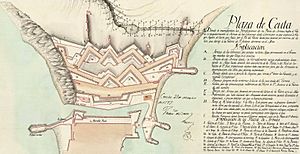
Map of the Royal Walls of Ceuta in 1797
|
|
| Coordinates | 35°53′19″N 5°19′8″W / 35.88861°N 5.31889°W |
| Type | Line of fortifications |
| Site information | |
| Open to the public |
Yes |
| Condition | Main walls intact Outworks partially intact |
| Site history | |
| Built | 962–18th century |
| Built by | Kingdom of Portugal Kingdom of Spain |
| In use | 10th–19th century |
| Battles/wars | Sieges of Ceuta |
| Official name | Conjunto Histórico Artístico Murallas Reales y foso de San Felipe |
| Type | Non-movable |
| Criteria | Monument |
| Designated | 3 July 1985 |
| Reference no. | RI - 53 - 0000305 |
The Royal Walls of Ceuta (Spanish: Murallas Reales de Ceuta) are a strong line of fortifications in Ceuta. Ceuta is a Spanish city located in North Africa. The oldest parts of these walls were built in 962. The newest sections were added in the 18th century. Most of the walls are still standing today. Only some outer defense parts are not complete. These walls are listed as a Spanish Property of Cultural Interest. This means they are very important to Spain's history and culture.
Contents
History of the Royal Walls
Ceuta has been an important naval base for a very long time. It was used by the Carthaginians and Romans. The city has had some form of defenses since at least the 5th century.
Building the Walls
In 1415, the Portuguese took control of Ceuta. They started to make the city's defenses much stronger in the 1540s. They built the Royal Walls, which included large defensive towers called bastions. They also added a moat filled with water that ships could use. A drawbridge allowed people to cross. Some of these original bastions, like Coraza Alta, Bandera, and Mallorquines, are still there.
Changes and Repairs
Ceuta became part of the Kingdom of Spain in 1669. This happened after the Iberian Union ended. In 1674, a big storm badly damaged the walls on the south side of the city. But they were fixed quickly. More outer defenses, called outworks, were added later to make the Royal Walls even stronger.
Defending Ceuta
The Royal Walls were very important during the Sieges of Ceuta. These attacks started in 1694. Whenever there was a break in the fighting, the Spanish added more outer defenses. A relief force arrived in 1720, ending the siege. At this time, the outer defenses were completely rebuilt. Ceuta was attacked again in 1721. But the walls were much stronger now. The last attempt by the Moors to take the city ended in 1734.
More changes were made to the walls in the 1730s. Another Moorish attack happened between 1790 and 1791, but it was stopped. During the Napoleonic Wars, British soldiers helped defend the city. The walls were no longer needed for defense in the 19th century. This is because new weapons made them less effective.
Modern Day Walls
Some parts of the walls, especially the outer defenses, were taken down. This made space for new buildings in the city. However, the main Royal Walls, their water-filled ditch, and the first line of outer defenses are still standing. They have been repaired and cared for in recent years. On July 3, 1985, they were officially named a Spanish heritage site. In 2007, the walls were one of 100 places considered for the 12 Treasures of Spain. They were the only one from Ceuta. Parts of the walls are open for people to visit today.
Layout of the Walls
The Royal Walls are a land front that stretches across the narrow strip of land. This strip of land, called an isthmus, connects Ceuta to the rest of North Africa.
Main Defenses
The walls have two large defensive towers, or bastions, at each end. These are called Baluarte de la Coraza and Baluarte de la Bandera. There is also a smaller bastion on the north side. A ditch filled with seawater protects these walls. Batteries (places for cannons) were also built on stone barriers on both sides of the walls.
Outer Defenses
The walls were once surrounded by many outworks. These included different types of outer defenses like hornworks, ravelins, and counterguards. Today, the first line of these outer defenses is still complete. But other parts were removed over the years. The east end of Ceuta also had two small bastions for protection.
Gallery
Images for kids
-
A 1998 25-peseta coin showing the Royal Walls.
See also
 In Spanish: Murallas Reales de Ceuta para niños
In Spanish: Murallas Reales de Ceuta para niños



